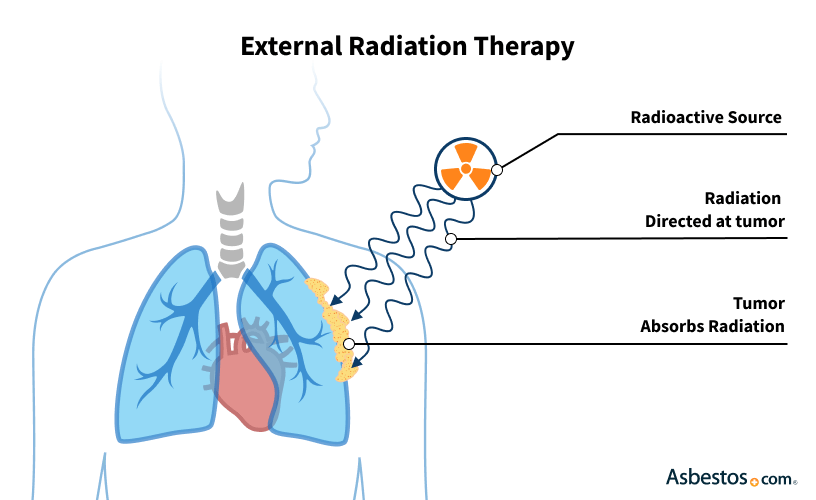After undergoing surgery in March 2016, King started radiation therapy at Maryland Proton Treatment Center. Proton therapy is one of the most specialized and precise forms of EBRT. Once she was done with her physical therapy, she began her six weeks of proton therapy at MPTC.
External Beam Radiation Therapy for Mesothelioma
In external beam radiation therapy, a machine outside the body shoots a beam of X-rays or charged particles at a patient’s cancer site. There are many types of external beam radiation. Specialists use the most sophisticated kinds to treat pleural mesothelioma.
What Is External Beam Radiation Therapy?
External beam radiation uses high-energy beams emitted from a machine to treat cancerous tumors. EBRT is the most common type of radiation treatment for pleural mesothelioma. The machine that creates the radiation is usually a linear accelerator or Linac machine.

During EBRT, you lie on a table while a machine directs energy beams at your tumor. Radiation oncologists program these beams to be shaped precisely to your body and tumor, minimizing damage to healthy tissue.
- Experienced mesothelioma specialists should perform EBRT.
- EBRT is the most common type of radiation therapy for pleural mesothelioma.
- It requires advanced technology to administer EBRT safely.
How Does External Beam Radiation Work for Mesothelioma?
EBRT is one of two main types of radiation therapy for mesothelioma and destroys mesothelioma cancer cells. The EBRT machine is set far from your body and doesn’t need to touch you to deliver radiation.
This sets EBRT apart from the second main type of radiation for mesothelioma, internal radiation therapy. IRT also destroys cancer cells, but during brachytherapy or other types of IRT, your doctor places a radioactive device inside your body near the tumor.
Types of External Beam Radiation Therapy for Mesothelioma
- Helical tomotherapy: This is a leading-edge form of radiation therapy that involves a lying down inside a donut-shaped machine. This machine can shine image-guided, intensity-modulated radiation on the patient from any angle.
- Image-guided radiation therapy: Radiation oncologists can use IGRT to make sure they concentrate the radiation on the right target. This involves scanning the patient’s body before each radiation treatment. Oncologists also pay close attention to how the tumor site moves in the body when the patient breathes.
- Intensity-modulated pleural radiation therapy: IMPRINT is a technique explicitly developed for pleural mesothelioma patients.
- Intensity-modulated radiation therapy: IMRT involves hitting the cancer from many different angles and changing the intensity of the radiation to suit each angle. Radiation oncologists use image scanning and computer modeling to fine-tune the radiation treatment.
- Three-dimensional conformal radiation therapy: 3D-CRT involves hitting the cancer from many different angles. This concentrates the radiation in the cancer while limiting how much radiation the rest of the body receives. Stereotactic body radiation therapy is a similar technique.
- Volumetric modulated arc therapy: VMAT is a newer form of EBRT that is faster and more accurate than standard IMRT.
Pleural mesothelioma develops in the membrane on the outside of the lungs. Radiation oncologists must use unique methods to make sure they can target cancer without hurting nearby lung and heart tissue.
Radiation therapy isn’t as effective in peritoneal mesothelioma treatment. Doctors may use it to prevent surgical tools from spreading cancer cells. More substantial types of radiation treatment are too dangerous to use in the abdomen.

Connect with top mesothelioma specialists, and get help scheduling appointments.
Find a Doctor NowProton Therapy
Proton therapy is another form of EBRT, but it isn’t yet a standard treatment for mesothelioma. Instead of using a beam of X-rays, some specialized cancer centers can use a beam of protons to kill cancer cells.
The advantage of proton therapy is that it causes much less collateral damage to healthy cells around the tumor site. Because there is less risk to the rest of the patient’s body, radiation oncologists can give the tumor site a more lethal dose of energy.
Benefits of EBRT
A significant benefit of EBRT is its effectiveness alongside other treatments, such as surgery, chemotherapy or immunotherapy. In aggressive multimodal treatment, doctors typically use radiation after surgery to kill cancer cells left behind.
A 2021 research study in AME Surgical Journal noted patients who received external beam radiation therapy after pleurectomy and decortication surgery had an overall survival of 13.5 months. This strategy is associated with better survival rates for patients. EBRT can also shrink tumors before surgery, which is called neoadjuvant therapy.
EBRT relieves symptoms as part of palliative care for mesothelioma. Palliative care helps mesothelioma patients manage pain and other symptoms. EBRT can shrink tumors, relieving chest pain and shortness of breath that can interfere with your daily life.
Side Effects of EBRT
Radiation therapy has mild side effects compared to chemotherapy for pleural mesothelioma, such as nausea and skin irritation. However, doctors must be cautious when giving a patient radiation therapy in the chest, as it can easily damage the lungs and heart if doctors don’t aim it carefully.
- Hair loss
- Headaches
- Loss of appetite
- Nausea
- Shortness of breath
- Skin irritation, soreness or redness
- Tenderness and inflammation at the treatment site
- Trouble swallowing
- Vomiting
Your health care team will work to minimize side effects, but most patients experience some adverse reactions. Side effects occur when your healthy cells receive radiation. Fatigue or tiredness is the most common side effect of EBRT. Every patient’s experience is different, and your side effects will depend on the dose and location of your treatment.
Recommended Reading


